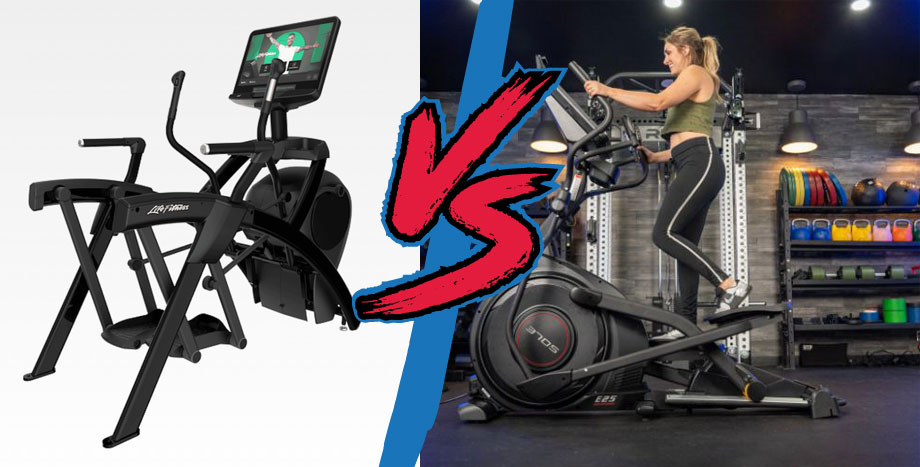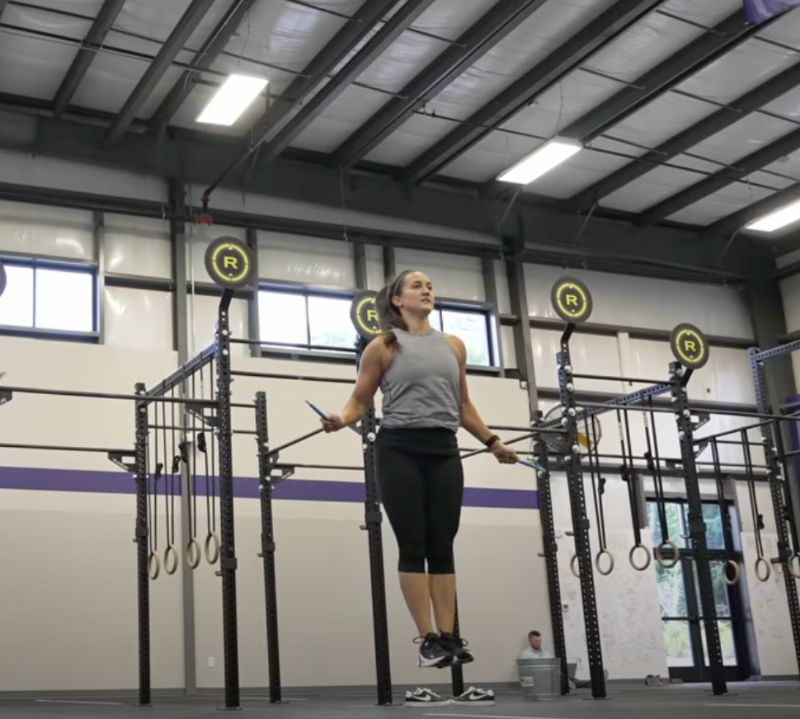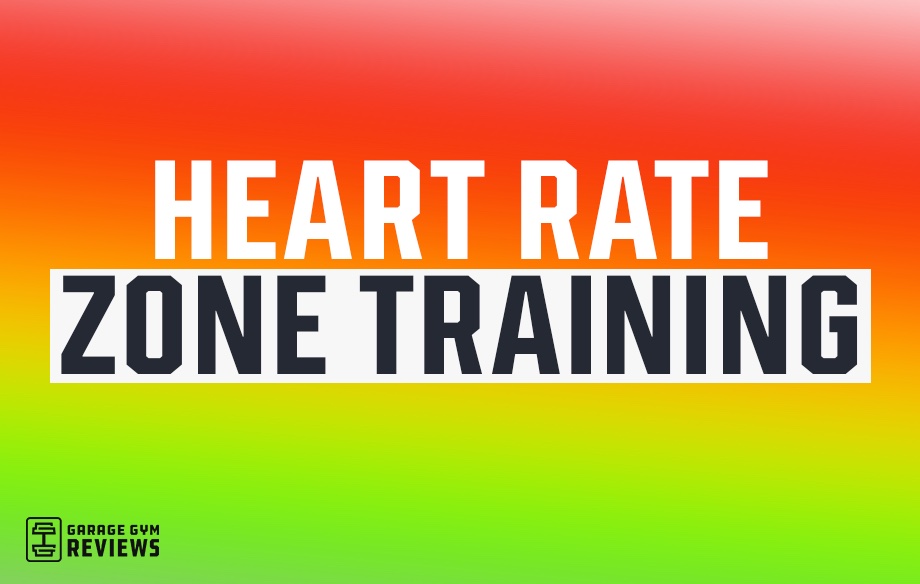Ellipticals are one of the most-favored cardio machines, thanks to the low-impact workout and ease of use provided. However, they’re often full at the gym, while the Arc trainer sits empty and ready to use. I believe this comes from a lack of familiarity with the Arc trainer, which is an excellent cardio option that can help maximize calorie burn with little to no stress on your joints.
So, should you get your cardio session going on the Arc trainer or wait for an elliptical to open up? Or, let’s say you’re building out your home gym and need to decide which is the best cardio machine.
In this guide to the Arc trainer vs elliptical, I’ll highlight the similarities and differences to help you decide which one best suits your cardio goals.
Quick Look: Arc Trainer vs Elliptical
When deciding which cardio machine you want to use (or purchase), you’ll want to consider your goals, your current fitness level, and whether you’re dealing with any joint or mobility problems.
While both machines are low-impact, there are some significant differences between them.
Who Should Buy An Arc Trainer
- Anyone with knee pain or joint issues
- Those who want to maximize their calorie burn
- People who want to target their quads and glutes
- Those who have the extra space or budget
Who Should Buy An Elliptical
- Those with a smaller gym space
- People who need a more low-budget option
- Anyone who doesn’t have joint or mobility issues
- People who want more advanced interactive programming
Arc Trainer vs Elliptical: What Are They?
Before outlining the key similarities and differences between these two pieces of cardio equipment, I’ll start with a quick rundown of each machine.
Elliptical
An elliptical trainer is a low-impact cardio machine that uses a gliding motion to simulate a hybrid between walking, running, and stair climbing. While some have fixed arms, most have foot pedals and arms that move in unison, which provides a full-body workout targeting the muscle groups in your lower body (quads, glutes, hamstrings, and calves) and upper body (biceps and upper back).
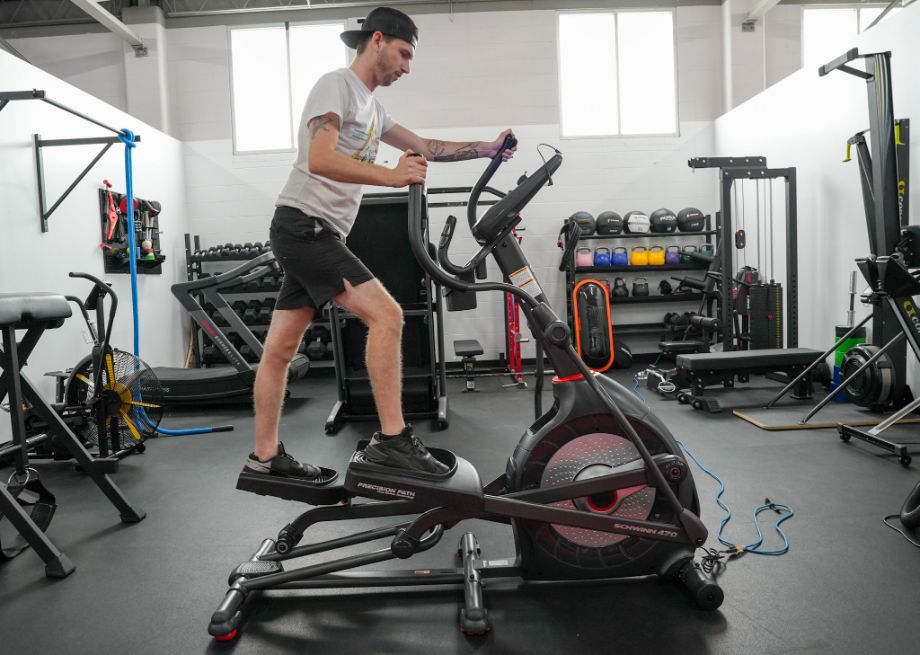
RELATED: Best Ellipticals
Typically, elliptical machines also offer different resistance levels and incline levels so you can customize the difficulty of your workout.
Arc Trainer
An Arc trainer is another low-impact cardio machine with foot plates that follow an arc motion, or curved path, instead of an oval-shaped path like an elliptical, which is considered a biomechanically correct path of motion that reduces stress on your knees and joints.
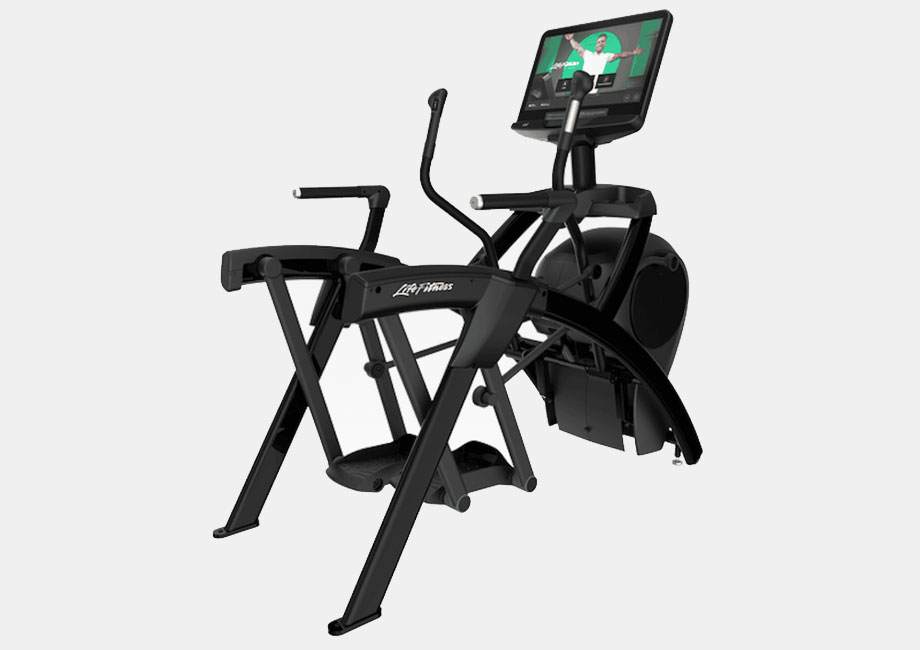
There are two types of arc trainers: lower body and total body. The lower-body Arc trainer has fixed arms, so it engages the muscles of the lower body and, to some degree, your core. The total-body Arc trainer has moveable arms that also activate the muscles in your upper body.
Comparison Chart
There’s one important thing I should note before comparing models. “Arc trainer” is a brand name for an exercise machine made by Cybex, a company owned by Life Fitness. Other manufacturers have similar machines with different names. For example, Precor makes the Adaptive Motion Trainer (AMT), which more or less offers the same type of workout.
For the sake of this comparison (and since it’s the most widely recognized), I’m using “Arc trainer” as a collective term to describe this category of fitness equipment.
As for ellipticals, there are many different types of ellipticals available, so the specs being compared here may differ. The Arc trainer is typically bigger, heavier, and more expensive than most ellipticals.
RELATED: Best Ellipticals Under $1,000
Here’s a quick breakdown:
| Arc Trainer | Elliptical | |
| Average dimensions | 76″ L x 30″ W x 62.5″ H | 52″ L x 29″ W x 66″ H to 70” H x 24” L x 71” W |
| Weight range | 364 lbs | 50-300 lbs |
| Maximum user weight capacity range | 400 lbs | 250-400 lbs, depending on the machine |
| Noise level | Minimal | Minimal |
| Price range | $8,000-$14,000 | $300-$6,500 |
| Interactive programming available | Yes, but limited | Yes, from basic to fully immersive, depending on the machine |
| Foldable models available? | No | Yes |
Key Similarities Between an Arc Trainer and an Elliptical
Here are a few ways that the Arc trainer and elliptical are interchangeable:
Both Provide A Great Cardio Workout
The biggest similarity between the arc trainer and an elliptical is that they’re both used for cardio workouts and can help you get your heart rate up. Cardio can help you burn fat and contribute to weight loss, but it has so many more health benefits beyond that, including:
- Improved heart health1
- Improved mental health2
- More brain power3
- Blood sugar regulation4
- Better sleep5
- Stronger immune system6
While the features and type of programming you get depend on which specific machine you choose, you can also do high-intensity interval training (HIIT) on both ellipticals and Arc trainers.
One thing to note is because ellipticals put more stress on your body (more on that later), the rate of perceived exertion can be higher. In other words, you may feel like you’re training harder on an elliptical than on an Arc trainer, but that doesn’t mean you’re burning more calories.
RELATED: What Does Cardio Do to Your Body?
Both Burn Calories
In addition to their cardioprotective benefits, both cardio machines may help you burn calories. As for how many, exactly? The Cybex Arc Trainer may have an edge here, although the jury’s still out.

Currently, there’s no published research comparing the two machines directly, but a no-longer-published study in 2010—done in partnership with Cybex International, FYI—found that the Arc trainer could burn about 16% more calories than elliptical trainers. The MyFitnessPal calorie-burn estimator shows similar results. When you plug in the same height and weight for a 30-minute session on each machine, the app says the Arc trainer will burn about 374 calories, while the elliptical will burn 306. That’s just over 20% more calories for a similar amount of effort.
RELATED: Activities That Burn the Most Calories
All in all, you’ll still get a decent calorie burn with both machines, especially if you dial up the incline and resistance.
Both Are Suitable For Beginners
Neither machine has much of a learning curve, which makes them a great option for beginners. You can get started right away and tailor your training to your fitness level.
RELATED: Cardio Exercises For Beginners
And unlike treadmills, which have powered belts, your movement controls the stride rate of both ellipticals and Arc trainers. That means when you stop, they stop. Because of this, there’s less of a safety issue than with a treadmill.
Important Differences Between an Arc Trainer and an Elliptical
Now that you know what makes the two machines alike, let’s take a look at what sets them apart:
Impact
Both types of cardio machines are technically considered low-impact, but that doesn’t necessarily translate to low-stress.
The Arc trainer follows an arc movement that’s more biomechanically correct, while the elliptical can force your knees into an unnatural position. It also requires more forward stress to move the elliptical since you have to “push” the pedals with your legs.
Additionally, the constant pedaling on an elliptical combined with limited ankle movement may cause an inward rotation7, which negatively affects your biomechanics. This can ultimately put more stress on the knee joints, which can be problematic for those with knee pain and/or injuries. On the other hand, Arc trainers are designed to balance your weight and keep your toes in front of your knees at all times. This reduces knee stress.
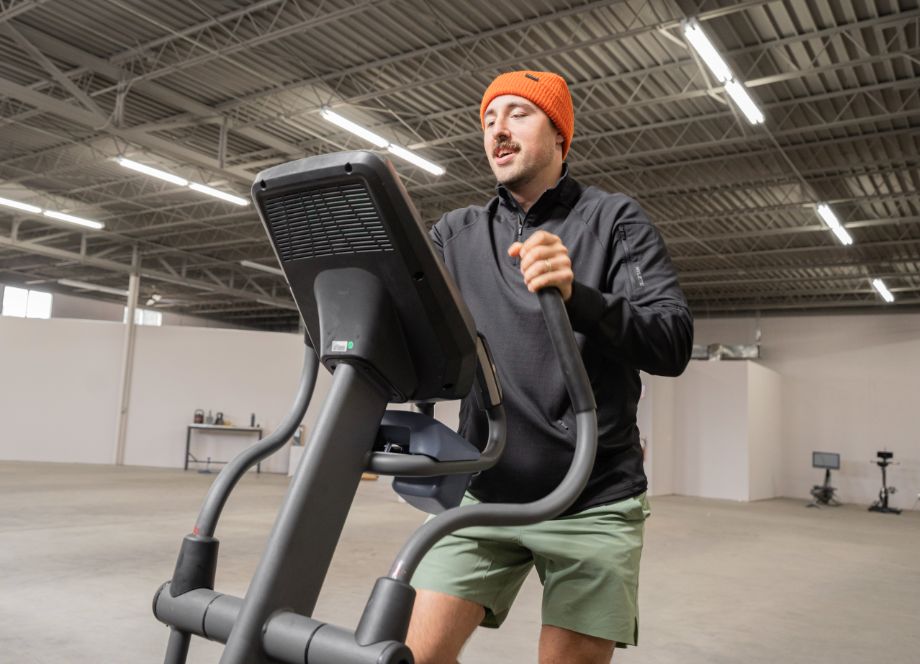
And you’ll be happy to know that less impact (and less stress) doesn’t mean you’ll get a less effective workout. In a 2020 study8 comparing Arc trainers to treadmills, researchers found that both types of cardio exercise provided similar health benefits, including increases in leg strength, decreases in body fat percentage, improved balance, and improvements in cholesterol, HDL, and LDL levels.
Muscles Worked
The muscles worked on an Arc trainer and Elliptical are similar, assuming you use a machine with movable arms. That said, the Arc trainer focuses more on the larger muscle groups in your lower legs.
RELATED: What Muscles Does An Elliptical Work?
At lower inclines, the Arc trainer mainly targets your glutes. At higher inclines, it’s quadriceps-dominant, similar to stair-stepping or climbing. There are movable arms, but your upper body isn’t as involved in the workout as with an elliptical.
The elliptical, on the other hand, activates your glutes, hamstrings, quads, and calves, plus your triceps and rhomboids.
Versatility
When it comes to versatility, the Arc trainer beats out an elliptical.
An elliptical generates a gliding motion that mimics running with less impact. Regardless of your incline and resistance level, the motion (and the muscles worked) remain the same.
While the general motion of the Arc trainer doesn’t change, the resistance and incline determine what type of movement it mimics. At lower incline levels, it glides similarly to cross-country skiing. At a mid-range incline level the motion imitates an elliptical, albeit with more upright positioning (you can’t hunch over as easily on an arc trainer). At higher incline levels, the movement becomes the ascent of a stair stepper or climbing machine.
This versatility makes it easier to vary your aerobic routine using only one piece of cardio equipment.
Price Range
You’ll shell out considerably more cash for an Arc trainer or similar equipment because Arc trainers are designed for commercial use—there currently aren’t any that are made specifically for home use.
On the other hand, ellipticals are more mainstream, and many home models are available. Because of this, you can find them at many different price points.
An actual Arc trainer costs about $8,000 to $14,000, while the AMT from Precor can cost $11,000 or more. At about $2,500, the NordicTrack version is less expensive, but it’s not exactly the same.
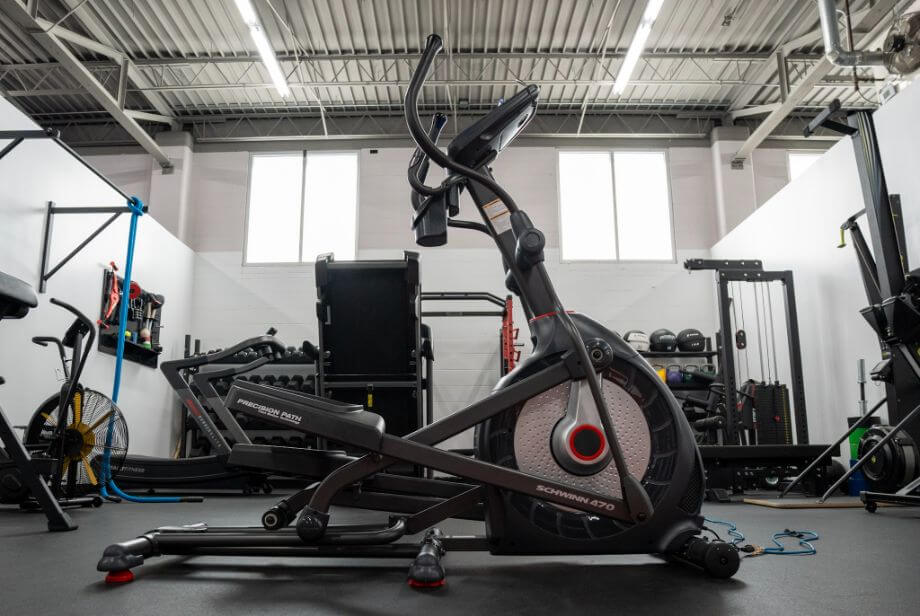
You may be able to find refurbished models for $3,000 to $5,000, which is in line for what you might pay for the most expensive elliptical trainer out there.
RELATED: Best Elliptical Under $500
You can purchase a budget elliptical for a few hundred dollars, while top-of-the-line, commercial models can cost as much as $6,500. Generally, you can expect to spend around $1,000 to $2,000 on a quality elliptical.
Arc Trainer vs Elliptical: Final Thoughts
Both low-impact cardio machines can help you burn calories while providing a total-body workout that’s good for your physical and mental health. The Arc trainer may be the better option to burn more calories and/or help with knee pain. If your goal is to engage more upper-body and lower-body muscles, then an elliptical is the way to go.
Overall, elliptical machines are much less expensive, so if you’re considering adding one to your home gym, you’ll have less sticker shock.
Arc Trainer vs Elliptical: FAQs
Is Arc trainer better than elliptical for weight loss?
Maybe. While there’s not a ton of research comparing the two, an Arc Trainer may burn about 20% more calories than an elliptical at the same amount of effort.
In theory, this could make it better for weight loss since you’ll burn more calories. However, both machines can help you reach your weight loss goals when combined with a healthy diet and other lifestyle changes, like a good sleep schedule.
Is an Arc trainer hard on your knees?
No, Arc trainers are designed to put little to no stress on your knees. They balance your weight, and the arc motion keeps your toes in front of your knees, reducing overall stress. They can be helpful for those with existing knee pain or problems that still want to do regular cardio.
What are the disadvantages of an elliptical?
Ellipticals typically have a large footprint, with limited size and height adjustability. They’re not as convenient as foldable treadmills and can take up a lot of space in your home gym. They can also present issues for people with mobility and/or stability issues, and can be harder on your joints (the knees, specifically) than Arc trainers.
RELATED: Best Compact Ellipticals
References
1. Pinckard, K, Baskin, KK, Stanford, KI. Effects of Exercise to Improve Cardiovascular Health. Front Cardiovasc Med. 2019;6:69. doi:10.3389/fcvm.2019.00069
2. Kandola, A, Ashdown-Franks, G, Stubbs, B, Osborn, DPJ, Hayes, JF. The association between cardiorespiratory fitness and the incidence of common mental health disorders: A systematic review and meta-analysis. J Affect Disord. 2019;257:748-757. doi:10.1016/j.jad.2019.07.088
3. Trombetta, IC, DeMoura, JR, Alves, CR, Carbonari-Brito, R, Cepeda, FX, Lemos JR Jr. Serum Levels of BDNF in Cardiovascular Protection and in Response to Exercise. Níveis Séricos do BDNF na Proteção Cardiovascular e em Resposta ao Exercício. Arq Bras Cardiol. 2020;115(2):263-269. doi:10.36660/abc.20190368
4. Amanat, S, Ghahri, S, Dianatinasab, A, Fararouei, M, Dianatinasab, M. Exercise and Type 2 Diabetes. Adv Exp Med Biol. 2020;1228:91-105. doi:10.1007/978-981-15-1792-1_6
5. Dolezal, BA, Neufeld, EV, Boland, DM, Martin, JL, Cooper, CB. Interrelationship between Sleep and Exercise: A Systematic Review. Adv Prev Med. 2017;2017:1364387. doi:10.1155/2017/1364387
6. Nieman, DC, Wentz, LM. The compelling link between physical activity and the body’s defense system. J Sport Health Sci. 2019;8(3):201-217. doi:10.1016/j.jshs.2018.09.009
7. He, MY, Lo, HP, Chen, WH. Effects of Stationary Bikes and Elliptical Machines on Knee Joint Kinematics during Exercise. Medicina (Kaunas). 2024;60(3):498. doi:10.3390/medicina60030498
8. Martins, D., Padavan, D., Kahn, A. et al.Effects of Impact Versus Non-impact Cardiovascular Machines in Individuals between Age 50 and 80 Years. Population Ageing. 2022: 15:581–593. https://doi.org/10.1007/s12062-020-09281-8


